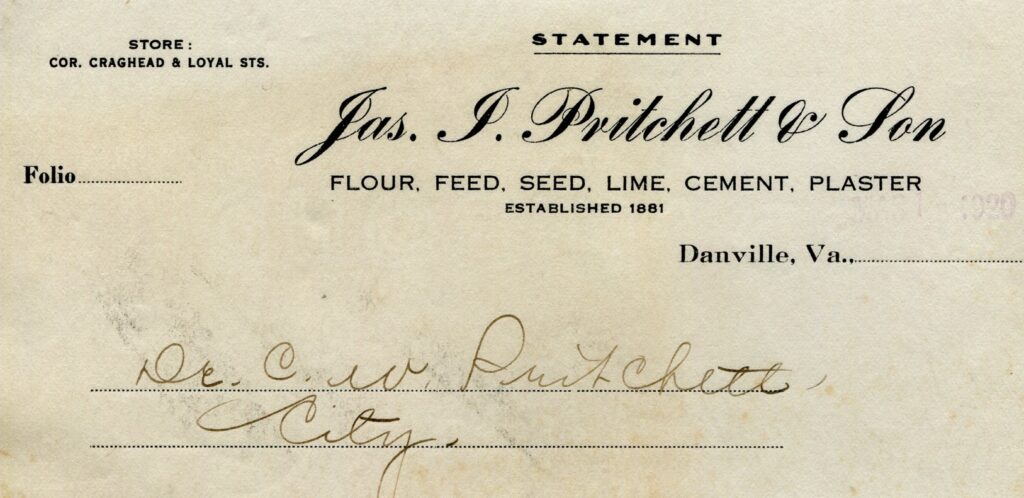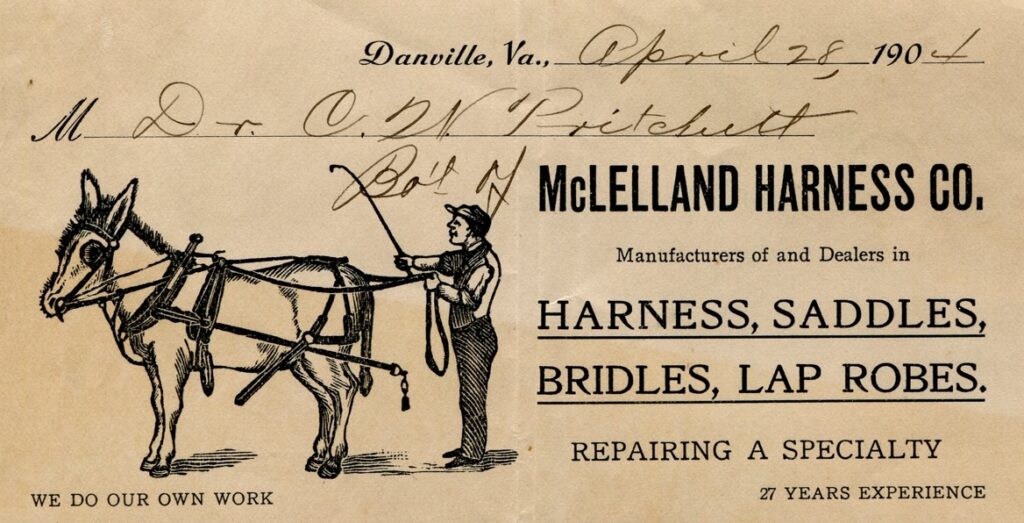
**This research was first published in the May 22, 2024 edition of the Chatham Star-Tribune newspaper as part of Kyle Griffith’s weekly segment entitled “Heritage Highlights.”
What was it like to shop around Danville and Pittsylvania County 100 years ago? Surviving receipts from transactions at local groceries, mills, and other services have been filed away for decades and help to paint a vivid picture of rural commerce and material culture. By examining these documents, one can get a glimpse into the types of goods available and the network of local businesses that formed the backbone of community business during that era. As a rule of thumb for visualizing the following prices post-inflation, $1 during the period of 1900-1917 was about the same as $30 today, while $1 during the period of 1918-1926 was about the same as $18 today.
The receipts of Dr. Charles Wesley Pritchett, Jr. (1864-1950) revealed the shopping habits of the city physician. Dr. Pritchett shopped often at stores within walking distance of his home in Danville. He frequented Council-Hill Grocery at 522 Main Street. Unfortunately the quantities were not recorded on the receipts, but the prices are still telling. A random selection of items included squash for 35 cents, snaps 30 cents, lemons 10 cents, and bread for 12 cents. Another store was located at 1005 Main Street called Gentry’s Grocery. A receipt from 1920 advertises fancy groceries and country produce. Dr. Pritchett purchased rice for 40 cents, lettuce 40 cents, bacon 70 cents, ham 70 cents, peas 50 cents, cocoa 30 cents, and celery for 50 cents. At C. H. Dodson & Co. Grocers, he purchased 21 chickens for $11.05. At Jas. I. Pritchett & Son’s store on the corner of Craghead & Loyal Streets, he purchased a barrel of flour for $14.75.
One of the oldest receipts is from The Danville Preparatory School in 1900 for the tuition of Dr. Pritchett’s son, Bernard. Rates were $3 per month. In 1902, a subscription to the Danville Register newspaper for the months of August to November cost $1.50. Dr. Pritchett also paid 15 cents to place an advertisement in the Danville Register. In 1903 Dr. Pritchett ordered from The Gravure Illustration Company in Chicago, who published an “Artwork of Danville” book in nine parts. He paid $16.65 for the book, which is equivalent to over $500 in the modern day. Very few copies of the book still exist today.
In 1919, Dr. Pritchett purchased ten gallons of motor gasoline from the Standard Oil Company for $2.50 or 25 cents per gallon. At Peerman & Fuller West-End Woodyard he purchased a half cord of wood for $6. At least once a month he also visited A. Ross, whose business boasted “Scientific Horse-Shoeing.” Normally two to four horse shoes were purchased during each visit at 25 cents per shoe. Lastly, in 1919, he visited J. & J. Kaufman’s Clothiers and Haberdashers at 331 Main Street in Danville to purchase a nice hat for $7.50.
Outside of the city, in rural communities such as Dry Fork and Whitmell, country stores provided most everything a farming family would require. Receipts from my great-great grandfather, Dock Meadows (1882-1942) reveal some of his purchases pertaining to the farm. In 1920, he purchased sixteen bags of fertilizer from L. C. Giles for $50.50. A selection from the Dry Fork Milling Company in 1926 shows the following purchases. Dock bought two rough plow handles 50 cents, one spool of thread 5 cents, 101 yards of plant bed cloth $5.05, a sack of Red Dog shipstuff $2.40, and an alarm clock for 25 cents. There are also receipts for 682 pounds of hay for $9.23, one barrel of flour $10.50, a bushel of potatoes $2, six pounds of pinto beans $9.54, twenty-five pounds of sugar $1.60, and three pounds of coffee for $1.
Reflecting on these preserved receipts from a century ago offers not only a nostalgic glimpse into Danville and Pittsylvania County’s past but also invites a fascinating comparison with today’s shopping habits. Where local customers once purchased entire barrels of flour and hundred-pound bags of shipstuff (a low-grade flour used for animal feed) modern consumers typically buy flour in small bags and find more specialized animal food. The scale and specificity of purchases have dramatically shifted. As people navigate the aisles of modern supermarkets or click through online grocery orders, these historical documents serve as reminders of a time before widespread commercial stores.

Receipt from James I. Pritchett & Son, dated 1920
Receipt from McLelland Harness Co., dated April 28, 1904

